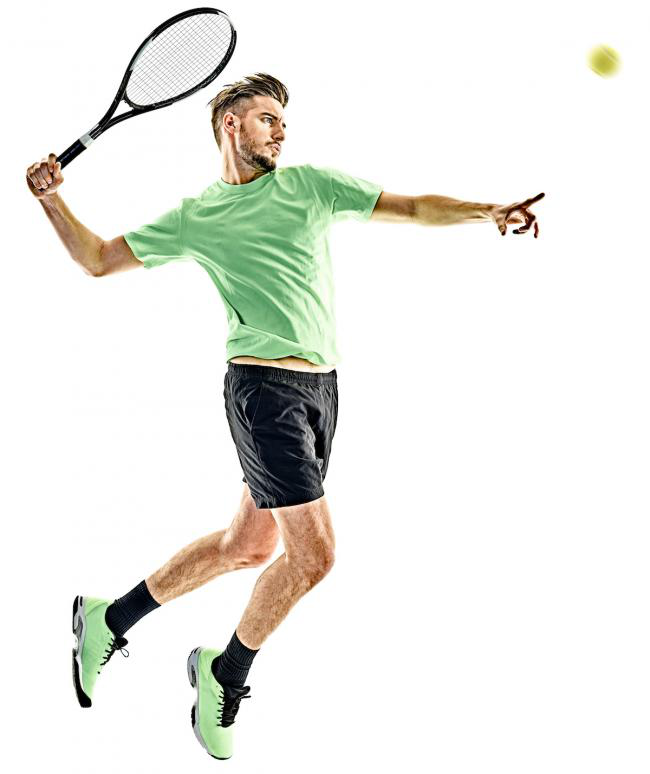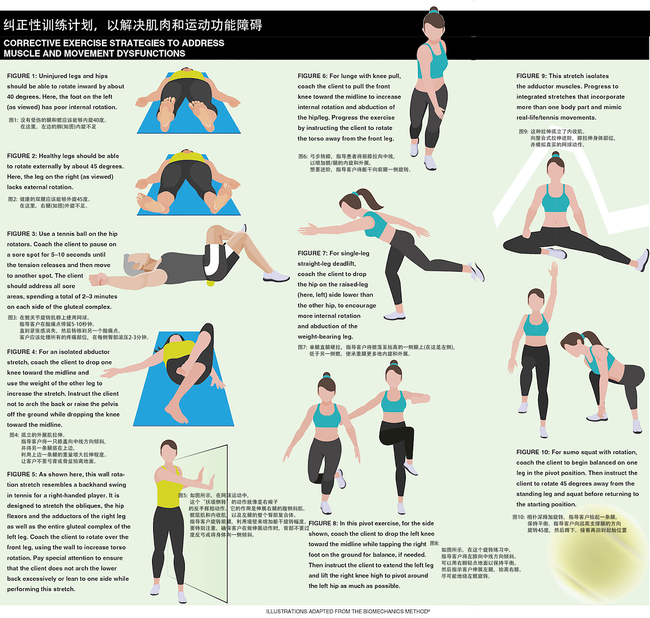在网球运动中减轻疼痛,提高运动表现
Tennis: Reduce Pain, Improve Performance
提高转髋能力可以使你的运动员提高爆发力,并减少损伤风险
Increasing hip rotation can help a client add power and lessen injury risk。

网球是世界上最受欢迎的运动之一。仅在美国,就有近1800万名网球选手,另外还有1400万网球爱好者(TIA 2018)。然而,网球运动带来的不仅仅是喜悦与快乐,比赛中的各种强劲的扭转及转体动作也增大了运动员的损伤风险(Roetert & Kovacs 2011)。
Tennis is one of the most popular sports in the world。 In the U.S。 alone, there are almost 18 million players, with another 14 million expressing interest (TIA 2018)。 Unfortunately, the dynamic, forceful twists and turns of the game pose ever-present injury risks to players (Roetert & Kovacs 2011)。
如果你的客户中有人喜欢网球运动,就需要去了解与网球有关的损伤。你需要有能力帮助客户改善动作能力、减轻疼痛并帮助他们回归赛场。
If your fitness clientele includes people interested in playing this sport, you need to understand the causes of tennis-related injuries。 This will help you develop strategies to improve movement function, reduce pain and keep clients on the court。
- 常见网球相关运动损伤的诱因
Causes of Common Tennis Injuries
网球运动员最常遭受膝、背部和肩部的关节及肌肉拉伤(Roetert & Kovacs 2011)。这些伤病的根源基于网球的生物力学特征。
Tennis players most often suffer joint and muscle strains to the knees, lower back and shoulders (Roetert & Kovacs 2011)。 The roots of these injuries start with basic tennis biomechanics。
网球场上的落地球—即正手和反手—击球时需要身体产生强大的力量。这一力量的产生主要来自于击球时快速的引拍和随挥。此时股骨在髋臼中转动,带动脊柱和肩膀旋转和手臂的挥动(Kovacs et al。 2016)。
Tennis groundstrokes—forehand and backhand—require the body to generate a lot of power to hit the ball。 This force results primarily from taking the racket back and following through quickly while striking the ball。 The legs pivot in the hip sockets, allowing the spine and shoulders to rotate and the arms to swing (Kovacs et al。 2016)。
为产生更大的力量,高水平的网球运动员经常在挥拍和随挥过程中有跳跃的动作。这些动作也会伴随腿/髋旋转,带动上半身的旋转。
To generate even more power, advanced tennis players often jump during the swing and follow-through。 These movements also sync with the leg/hip pivot to help generate upper-body rotation。
因此,充分转髋是网球中旋转类动作的基础。此外,充分的转髋活动范围能够减轻关节、肌腱、肌肉和其他最容易受伤的组织的压力(Kovacs et al。 2016)。膝是一个铰链关节,主要功能是屈和伸。腰椎可以旋转,但不如髋关节灵活。肩胛骨随着躯干的扭转前伸、后缩,但也不如髋关节那样灵活。
Thus, ample rotation of the hips is fundamental to many tennis moves that require rotation。 Moreover, adequate hip rotation mitigates stress to the joints, tendons, muscles and other tissues most prone to tennis injuries (Kovacs et al。 2016)。 The knees are a hinge joint designed primarily to flex and extend。 The lumbar spine can rotate but not as effectively as the hips。 The shoulder blades protract and retract as the torso twists, but they lack the rotational capacity of the hips (Price & Bratcher 2010; McGill 2016; Cook et al。 2010)。
因此,加强转髋能力可以降低网球运动导致的局部过用性损伤的风险,潜在地防止膝、下背部和肩膀的疼痛及损伤。
Enhancing hip rotation therefore reduces the risks of tennis-induced overuse, potentially preventing pain and/or injury to the knees, lower back and shoulders。
你可以使用以下3步来帮助你的运动员提高转髋能力:
You can improve clients’ hip rotation with a three-step process:
- 评估他们髋关节内外旋的能力,寻找动作受限的地方。
Assess their ability to internally and externally rotate the hips, looking for movement restrictions。
- 找出造成动作受限的肌肉和其他软组织结构。
Identify muscles and other soft-tissue structures affected by the movement restrictions。
- 选择和设计适当的纠正性训练计划,解决肌肉和运动功能障碍。
Select and design appropriate corrective exercise strategies to address muscle and movement dysfunctions (Price 2018)。
以下是三个步骤的详述。
Let’s explore these steps in greater detail。
- 步骤一:评估髋关节内外旋
Step 1: Assess Internal and External Hip Rotation
髋关节必须能够内外旋,这样网球运动员才能做出有力的、“无痛”的击球动作。以下建议可以帮助你评估客户的髋关节旋转情况:
The hips must rotate internally and externally to allow a tennis player to make powerful, “pain-free” strokes。 These tips will help you assess a client’s hip rotation:
- 髋关节内旋
Internal Hip Rotation
让你的客户躺在地板上,双腿分开18-24英寸。让他或她试着将双腿向内转动,这样双脚就会互相靠近。在双腿内旋时,提醒你的客户不要屈膝,且骨盆不要离开地面。
Have your client lie on the floor with legs spread about 18–24 inches apart。 Coach him or her to try turning both legs inward so the feet move toward each other。 Tell the client not to bend the knees or let the pelvis lift off the ground as the legs rotate inward。
接下来,看看你的客户能把腿向内旋转多少度。两条腿都应该能转40度左右。评估两侧是否有明显差异,或者两边都存在内旋不足的情况。在图1中,被评估者的一条腿的运动范围尚可,而另一条腿严重缺乏向内旋转的灵活性。
Next, see how far your client can turn the legs toward the midline。 Both legs should be able to turn in about 40 degrees。 Assess if one leg cannot turn in as far as the other leg or if both sides lack internal rotation。 In Figure 1, the client has an almost acceptable range of motion in one leg, while the other leg severely lacks the mobility to rotate inward。
- 髋关节外旋
External Hip Rotation
指导你的客户把双腿向外旋转,这样双脚就会远离。看看他或她的双腿能外旋多少度。再次提醒你的客户不要屈膝,且骨盆不要离开地面。两条腿应该都能外旋45度左右。评估两侧是否有明显差异,或者两边都存在外旋不足的情况。在图2中,被评估者一条腿可以轻松的外旋超过45度,但另一条腿外旋受限。
Instruct your client to try turning both legs outward so the feet move away from each other。 See how far he or she can turn the legs away from the midline。 Again, remind the client not to bend the knees or let the pelvis lift off the ground as the legs rotate outward。 Both legs should be able to turn out about 45 degrees。 Assess if one leg cannot turn out as far as the other leg or if both sides lack external rotation。 In Figure 2, the client can externally rotate one leg well past 45 degrees, but the other leg has only limited external rotation。
- 步骤二:确认影响动作的软组织结构
Step 2: Identify Affected Soft-Tissue Structures
髋关节内外旋活动范围不足的客户可能会有软组织及肌肉失衡问题。
A client who cannot internally or externally rotate the hips may have problematic soft-tissue and muscle imbalances (Kovacs et al。 2016)。
- 旋转髋关节的肌肉
Muscles That Rotate The Hips
对功能解剖学的全面了解——包括影响髋关节功能的肌肉——能帮你找到最有针对性的纠正性训练。例如,髋关节内旋受限可能是由于肌肉紧张和/或臀大肌;臀小肌的后束,阔筋膜张肌和臀中肌;髋关节旋转肌群,内收肌和髋屈肌;腹斜肌 (间接地)等肌肉的限制。相反,髋关节外旋受限或许会反映出髋关节内收肌和髋关节旋转肌群;阔筋膜张肌上束、臀小肌和臀中肌;腘绳肌内侧;腹斜肌(间接)等肌群的软组织出现问题或功能障碍(Price 2018; Gray 1995)。
A thorough understanding of functional anatomy—including the muscles that affect hip function—is crucial to choosing the most appropriate corrective exercises。 For example, inability to internally rotate the hip may result from muscle tightness and/or restriction in the gluteus maximus; in the posterior fibers of the gluteus minimus, tensor fasciae latae and gluteus medius; in the hip rotators, adductors and hip flexors; and in the obliques (indirectly)。 Conversely, an inability to externally rotate the hip may reflect soft-tissue restriction or dysfunction in the hip adductors and hip rotators; in the anterior fibers of the tensor fasciae latae, gluteus minimus and gluteus medius; in the medial hamstring muscles; and in the obliques (indirectly) (Price 2018; Gray 1995)。
在你的评估中,询问客户最紧张或受限最多的地方。这些信息将帮助你确认最需要纠正性训练介入的肌肉和软组织结构。
In your assessment, ask where the client feels the most tightness or restriction。 This information will help you identify the muscles and soft-tissue structures that need the most help from corrective exercises。
- 步骤三:选择合适的纠正训练
Step 3: Choose Appropriate Corrective Exercises
接下来:开始整合那些可以帮助客户改善髋关节功能、提高运动表现、减轻疼痛及伤害的纠正训练。
Next up: Start integrating corrective exercises that can help the client improve hip function, enhance movement performance, and decrease the incidence of pain and/or injury from playing tennis。
从自我肌筋膜放松(或自我按摩)开始,接着恢复和再生功能失衡的软组织和肌肉,然后进行拉伸和力量加强练习(Price & Bratcher 2010;Rol1989;Myers2008)。左右两边都要做。
Begin with self-myofascial release (or self-massage) techniques to rejuvenate and regenerate dysfunctional soft-tissue structures and muscles, and then move on to stretching and strengthening exercises (Price & Bratcher 2010; Rolf 1989; Myers 2008)。 Repeat all exercises on both sides of the body。
- 提高髋内旋能力
Improving Internal Rotation
自我肌筋膜放松。使用泡沫轴(或类似设备)来处理较大的区域和整个肌肉群,如臀大肌和内收肌,可能会增强你的客户内旋髋关节的能力。使用较小的按摩器,如网球,解决特定的肌肉功能障碍区域,如髋关节外展肌和阔筋膜张肌的后束和下束、髋关节屈肌群的起点、髋关节旋转肌群等等(图3)(price2018;price2013)。在客户自我肌筋膜放松期间,询问压痛点的感受,确定哪些特定的结构需要处理以改善内旋活动度。
Self-myofascial release。 Use a foam roller (or similar equipment) to address larger areas and entire muscle groups, such as the gluteus maximus and adductors, that might affect a client’s ability to internally rotate the hips。 Use smaller massagers, like tennis balls, to address specific muscle-dysfunction areas, such as the posterior fibers of the hip abductors and tensor fasciae latae, the origin of the hip flexor group, the hip rotators, and so on (Figure 3) (Price 2018; Price 2013)。 During self-myofascial release exercises, ask the client for feedback on tender areas to help you identify which specific structures need to be addressed to improve movement。
拉伸和灵活性。肌肉的疼痛减轻、功能恢复后,就可以开始进行拉伸练习来增加肌肉的柔韧性,以增强髋关节内旋能力。从臀大肌、髋关节外展肌、髋屈肌和内收肌、阔筋膜张肌以及髋关节旋转肌群的分离式拉伸开始。(图4)
Stretching and flexibility。 Once you’ve restored the health and suppleness of a client’s muscles, begin introducing stretching exercises to increase the flexibility of the muscles needed to facilitate better internal hip rotation。 Start with isolated stretches of the gluteus maximus, hip abductors, flexors and adductors, tensor fasciae latae, and hip rotators (Figure 4)。
随着软组织结构的柔韧性的增加,需要采用更多动态形式的拉伸:即包含多个身体部位且模仿网球专项动作的拉伸。(图5)
As the flexibility of individual soft-tissue structures increases, incorporate more dynamic forms of stretching that introduce multiple parts of the body and mimic tennis-specific movements (Figure 5)。
纠正性强化练习。当你的客户获得了理想的髋关节内旋活动范围后,即可以开始整合力量加强练习。让病人的脚踩在地上,对要训练的部位施加离心负荷(在张力下拉长)。要做闭链练习。
Corrective strengthening exercises。 When your client has achieved the desired range of internal hip rotation, start integrating strengthening exercises that will eccentrically load (lengthen under tension) the appropriate structures with the client’s feet on the floor。 You’re looking for closed-kinetic-chain exercises。
挑选通过旋转躯干到承重侧来内旋股骨的一类动作。如弓步屈膝抬腿(图6)和髋关节屈曲的单腿直腿硬拉(目标腿/髋在身体前面)(图7),或髋关节伸展的旋转运动(目标腿/髋伸直和/或身体后面)(图8)。
Select movements that internally rotate the leg by pivoting the torso around the weight-bearing side。 Choose moves like lunge with knee pull (Figure 6) and single-leg straight-leg deadlift (Figure 7), where the hip is flexed (and target leg/hip in front of the body), or a pivot exercise (Figure 8), where the hip is extended (target leg/hip straight and/or behind the body)。
随着您客户的活动能力的提高,可以通过在练习中加入外界负荷来进阶。可能的选择包括药球、轻哑铃或阻力带。
As your client’s movement capabilities improve, progress the strengthening phase of the program by adding external loads to the exercises。 Possible options include holding a medicine ball or light weight and/or using resistance bands。
- 提高髋外旋能力
Improving External Rotation
自我肌筋膜放松。如果你的评估显示客户缺乏髋外旋能力,可以对内收肌、腿内侧的腘绳肌(半腱肌)、外展肌群前束(臀中肌、臀小肌和阔筋膜张肌)和髋旋转肌群使用自我肌筋膜松解
Self-myofascial release。 If your assessment reveals that the client lacks external rotation, use self-myofascial release techniques for the adductors, the hamstring muscles toward the medial side of the leg (semitendinosus), the anterior fibers of the abductors (gluteus medius, gluteus minimus and tensor fasciae latae), and the hip rotators。
拉伸和灵活性。从分离式拉伸开始,然后进阶到整合式拉伸,改善关节活动范围,为力量加强阶段打基础。(图9)
Stretching and flexibility。 Progress to isolated, and then integrated, stretching techniques that improve these muscles’ ROM in preparation for the strengthening phase of the program (Figure 9)。
纠正性强化训练。当你的客户因活动范围的增加而获得信心和能力后,加入离心力量训练来提高髋关节外旋能力。加入承重腿的脚触地,上半身围绕腿/髋部进行旋转的练习。(图10)
Corrective strengthening exercise。 As your clients gain confidence and competence with increased ROM, incorporate eccentric strengthening exercises to increase external hip rotation。 Pivot the upper body around the leg/hip, using exercises where the foot of the weight-bearing leg is in contact with the ground (Figure 10)。
像所有的力量加强练习一样,练习当中可以通过增加外界负荷及不可控变量。例如,可以指导您的客户做动作时完成接球和投球。
Like all strengthening exercises, these moves can be progressed by adding external loads and/or uncontrollable variables。 For example, you could coach your client to catch and throw a ball while performing the desired movement。
- 网球和其他扭转运动的正确动作
The Right Moves for Tennis and Other Twisting Sports
足够的髋关节内外旋活动范围可以提高网球运动表现,并减少背部、膝盖及肩膀的疼痛和损伤风险。在其他需要躯干有力旋转的运动中,良好的髋关节旋转能力也可以促进发力,并减少骨骼肌肉的压力。
Effective internal and external rotation of the hips can improve tennis performance and decrease pain and injury to the lower back, knees and/or shoulders。 Hip rotation is also essential for producing power and minimizing musculoskeletal stress during other sports movements that require forceful rotation of the trunk (e.g。, executing a golf swing, throwing a baseball, throwing a discus or Frisbee® disc, etc。)。
因此,识别和纠正髋关节旋转能力的不足,不仅可以使你的运动员在网球场上更具有运动能力,还能在各种运动中减少可能的疼痛和损伤风险。
Therefore, identifying and correcting flaws in hip rotation will make a client not only more athletic on the tennis court but also less likely to suffer pain and injury in a wide range of other sports and activities。
- 纠正性训练计划,解决肌肉和运动功能障碍
Corrective Exercise Strategies to Address Muscle and Movement Dysfunctions

Cook, G。, et al。 2010。 Movement: Functional Movement Systems: Screening, Assessment, Corrective Strategies。 Aptos, CA: On Target Publications。
Gray, H。 1995。 Gray’s Anatomy。 New York: Barnes & Noble Books。
Kovacs, M.S。, et al。 2016。 Complete Conditioning for Tennis (2nd ed。)。 Champaign, IL: Human Kinetics。
McGill, S。 2016。 Low Back Disorders: Evidence-Based Prevention and Rehabilitation (3rd ed。)。 Champaign, IL: Human Kinetics。
Myers, T.W。 2008。 Anatomy Trains: Myofascial Meridians for Manual and Movement Therapists(2nd ed。)。 New York: Churchill Livingstone。
Price, J。, & Bratcher, M。 2010。 The BioMechanics Method Corrective Exercise Specialist Certification Program。 San Diego: The BioMechanics Press。
Price, J。 2018。 The Biomechanics Method for Corrective Exercise。 Champaign, IL: Human Kinetics。
Price, J。 2013。 The Amazing Tennis Ball Back Pain Cure。 San Diego: The BioMechanics Press。
Roetert, P。, & Kovacs, M.S。 2011。 Tennis Anatomy。 Champaign, IL: Human Kinetics。
Rolf, I.P。 1989。 Rolfing: Reestablishing the Natural Alignment and Structural Integration of the Human Body for Vitality and Well-Being (rev。 ed)。 Rochester, VT: Healing Arts Press。
TIA (Tennis Industry Association)。 2018。 Tennis participation in the U.S。 grows to 17.9 million players。 Accessed June 5, 2018: tennisindustry.org/cms/index.cfm/news/tennis-participation-in-the-us-grows-to-179-million-players/。
作者:Justin Price, MA
译者:王溪宣


